|
|
|
Sort Order |
|
|
|
Items / Page
|
|
|
|
|
|
|
| Srl | Item |
| 1 |
ID:
187033
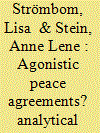

|
|
|
|
|
| Summary/Abstract |
Later years have seen the growth of a vibrant theoretical discussion on agonistic peace and the importance of creating space for contestation, plurality, and dissensus post-accord. However, there has been very few attempts at embedding agonistic theory in empirical analyses of peace agreements. This study attends to that lacuna by investigating how agonistic principles can be integrated and investigated in peace agreements. We suggest a threefold set of indicators for assessing the degree to which peace agreements are invested with agonistic dynamics: (1) what types of spaces for interaction are offered post-accord; (2) what forms of inclusion are stipulated; and (3) how is the peace agreement framed in terms of conflict termination and consensus/dissensus? We illustrate how the various indicators could be put into motion in concrete analyses applying them to examples from the Oslo Accords, the Belfast Agreement, and the Colombian Peace Agreement. Finally, we discuss four dilemmas and problematiques of integrating agonistic ideas in peace agreements; the issue of power, the mixing of agonistic and liberal ideals in peace agreements, the principle of ‘nothing is agreed until everything is agreed’ and the related double-edged potential of constructive ambiguity and finally the challenges of implementing peace agreements.
|
|
|
|
|
|
|
|
|
|
|
|
|
|
|
|
| 2 |
ID:
073583


|
|
|
| 3 |
ID:
133711
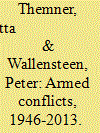

|
|
|
|
|
| Publication |
2014.
|
| Summary/Abstract |
In 2013, the Uppsala Conflict Data Program (UCDP) recorded 33 armed conflicts with a minimum of 25 battle-related deaths, up by one from 2012. Seven of these were recorded as wars, that is conflicts leading to 1,000 or more battle-related deaths in a calendar year. There have been 144 armed conflicts (47 wars) since 1989 and 254 armed conflicts (114 wars) since 1946. For the past ten years the amount of active armed conflict has fluctuated between 31 and 37. Six peace agreements were signed during the year 2013, two more than in the previous year. For the first time, this article also provides data on trends in battle-related deaths since 1989. These data do not show a clear time-trend. However, there is a particular difficulty in mapping the conflict in Syria, for which no credible battle-related deaths in 2013 can yet be reported.
|
|
|
|
|
|
|
|
|
|
|
|
|
|
|
|
| 4 |
ID:
140084
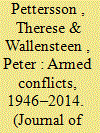

|
|
|
|
|
| Summary/Abstract |
In 2014, the Uppsala Conflict Data Program (UCDP) recorded 40 armed conflicts with a minimum of 25 battle-related deaths, up by six from 2013. This is the highest number of conflicts reported since 1999, and 11 of these conflicts were defined as wars, that is, conflicts generating 1,000 or more battle-related deaths in one calendar year. Further, an escalation of several conflicts, coupled with the extreme violence in Syria, resulted in the highest number of battle-related deaths in the post-1989 period. Yet, compared to the large-scale interstate wars of the 20th century, the number of fatalities caused by armed conflicts in 2014 was relatively low. Additionally, seven conflicts identified in 2013 were no longer active in 2014. However, four new conflicts erupted in 2014, all of them in Ukraine, and three previously registered conflicts were restarted by new actors. Furthermore, six conflicts reoccurred with previously registered actors. A positive development, however, is the increase to ten of the number of peace agreements concluded and signed in 2014, which represents a further four compared with 2013. And although this increase is part of a positive trend since 2011, it is worth noting that several peace processes remained fragile by the end of the year.
|
|
|
|
|
|
|
|
|
|
|
|
|
|
|
|
| 5 |
ID:
187391
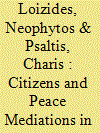

|
|
|
|
|
| Summary/Abstract |
How can areas of potential agreement be identified and endorsed by citizens in protracted conflicts? In an effort to answer this question, the article introduces a conjoint experiment across the ethnically and territorially split communities of Cyprus and tests a range of hypotheses about the structure of public opinion with respect to a future settlement. We test hypotheses on security and credible commitments, the legacy of past negotiations, as well as transitional justice mechanisms following United Nations plans to mediate the conflict between Greek and Turkish Cypriots. Contrary to conventional wisdom, we demonstrate that a zone of possible agreement (ZOPA) exists from a public opinion perspective. We specifically explore power-sharing in the context of security, provisions for the internally displaced, federal courts, and territorial readjustments and highlight their relative importance for public opinion interventions across conflict-ridden societies.
|
|
|
|
|
|
|
|
|
|
|
|
|
|
|
|
| 6 |
ID:
097771


|
|
|
|
|
| Publication |
2010.
|
| Summary/Abstract |
Negotiated civil war terminations differ from their interstate war counterparts in that one side must disarm and cease to exist as a fighting entity. While termination through military victory provides a relatively more enduring peace, many civil wars end with peace agreements signed after negotiations. However, research has shown that the implementation of civil war peace agreements is difficult and prone to collapse. Often these failures are followed by recurrence of the conflict. In some cases, the agreements break down before key provisions are implemented. This article adds to this topic by focusing on the role of state capacity in peace agreement success. We argue that peace agreements and state capacity are necessary but not sufficient conditions for sustainable peace. The article employs a case study approach to explore the importance of state capacity in implementing civil war peace agreements. The role of third-party interventions is also considered. The cases (United Kingdom-Northern Ireland, Indonesia-Aceh, Burundi, Mali, and Somalia) include 14 peace agreements that vary by war type (secessionist or control over government), type of agreement (comprehensive or partial), levels of state capacity (high or low), and peace success (success, partial or failure), and each experienced third-party involvement in the peace process.
|
|
|
|
|
|
|
|
|
|
|
|
|
|
|
|
| 7 |
ID:
105643
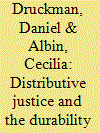

|
|
|
|
|
| Publication |
2011.
|
| Summary/Abstract |
This study explores the relationship between principles of distributive justice (DJ) and the durability of negotiated agreements. Sixteen peace agreements negotiated during the early 1990s were coded for the centrality of each of four principles of DJ - equality, proportionality, compensation, and need - to the core terms of the agreement. The agreements were also assessed on scales of implementation and durability over a five-year period. Another variable included in the analysis was the difficulty of the conflict environment. These data were used to evaluate three sets of hypotheses: the relationship between DJ and durability, the role of the conflict environment, and types of DJ principles. The results obtained from both statistical and focused-comparison analyses indicate that DJ moderates the relationship between conflict environments and outcomes: when principles of justice are central to an agreement, the negative effects of difficult conflict environments are reduced; when principles are not central, the negative effects of difficulty are heightened. These relationships are accounted for primarily by one of the four DJ principles - equality. Implications of these findings are discussed along with a number of ideas for further research.
|
|
|
|
|
|
|
|
|
|
|
|
|
|
|
|
| 8 |
ID:
144447


|
|
|
|
|
| Summary/Abstract |
Scholars and policymakers argue that violent actors – termed ‘spoilers’ – pose a significant threat to civil war peace agreements. Yet existing research, which is overly reliant on single-case studies, has not effectively determined how prevalent spoiling is, or thoroughly examined what its ultimate effects are on peace agreements. This article draws on a newly constructed cross-national dataset of spoiling following 241 civil war peace agreements in the post-Cold War era to analyze spoiling. It finds that spoiling intended to terminate an agreement is not as common as typically assumed, but still plagues a sizeable number of peace agreements. Moreover, most actors who resort to this strategy typically fail in their goals and the agreement is not at risk, despite the high publicity and attention given to these threats. Yet particular types of actors, most notably paramilitaries and state security forces excluded from the agreement, can pose a significant threat to peace.
|
|
|
|
|
|
|
|
|
|
|
|
|
|
|
|
| 9 |
ID:
189354
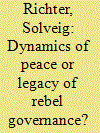

|
|
|
|
|
| Summary/Abstract |
In the academic literature, it is widely accepted that one of the most difficult steps in a peace process is the reincorporation of former combatants. Colombia is a case in point. After the peace agreement with the former rebel group FARC-EP in 2016, the reintegration process of more than 13.000 ex-combatants has been marred with difficulties, be it half-hearted implementation of the stipulations of the accord from the side of the government or the re-armament of some dissident groups. However, the dynamics of the peace process differ considerably between the national and the local level, offering a wide range of pathways from even more violent confrontation up to successful reincorporation projects. In order to explain this variety, we integrate DDR and rebel governance studies and assume that socio-political orders need to be re-configurated when rebel groups have established strong forms of rebel governance, as was the case with the FARC-EP. We argue that patterns of interaction between local conflict-affected communities and ex-combatants are the key explanatory variables for the dynamics of peace processes at local level. We differentiate between clustered and entrenched post-war orders and demonstrate our argument with two case studies based on comprehensive field research.
|
|
|
|
|
|
|
|
|
|
|
|
|
|
|
|
| 10 |
ID:
183953
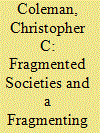

|
|
|
|
|
| Summary/Abstract |
The cases of peacemaking in Kosovo and Sudan/South Sudan yield insights into the interplay of international politics, relations among political elites, and reconciliation among identity groups. A durable, positive peace requires an approach by peacemakers that encompasses all these dimensions. Complicating matters, the readiness of states to adhere to rules and norms built up over decades has declined in recent years. Absent a concerted effort to (re)build them, the work of peace mediation will become more challenging and the odds of success incalculably longer. This, in turn, will corrode the ability of external powers, competing via proxy, to work together even on unrelated matters in different parts of the globe.
|
|
|
|
|
|
|
|
|
|
|
|
|
|
|
|
| 11 |
ID:
168863
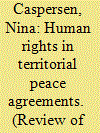

|
|
|
|
|
| Summary/Abstract |
Justice and peace are commonly seen as mutually reinforcing, and key international peacebuilding documents stress the importance of human rights. Is this apparent normative shift reflected in post-Cold War peace agreements? The existing literature is divided on this issue but has crucially treated both conflicts and peace agreements as aggregate categories. This article argues that the conflict type and the agreement's ‘core deal’ impact on the inclusion, or exclusion, of human rights provisions. Based on new coding of the 29 comprehensive agreements signed between 1990 and 2010, it compares agreements signed in territorial and non-territorial conflicts, and agreements with and without territorial autonomy. Qualitative Comparative Analysis is used to examine the different combinations of conditions that led to the inclusion of human rights. The analysis finds that agreements signed in territorial conflicts are significantly less likely to include effective human rights provisions, especially if the settlement includes territorial autonomy. Moreover, such provisions tend to be the result of high levels of international involvement, and the consequent lack of local commitment, or outright resistance, undermines their implementation. These findings point to important trade-offs between group rights and individual rights, and qualifies the notion of a liberal peace.
|
|
|
|
|
|
|
|
|
|
|
|
|
|
|
|
| 12 |
ID:
158921
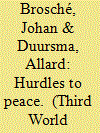

|
|
|
|
|
| Summary/Abstract |
Why do some peace agreements end armed conflicts whereas others do not? Previous studies have primarily focused on the relation between warring parties and the provisions included in peace agreements. Prominent mediators, however, have emphasised the importance of stakeholders at various levels for the outcome of peace agreements. To match the experience of these negotiators we apply a level-of-analysis approach to examine the contextual circumstances under which peace agreements are concluded. While prominent within the causes of war literature, level-of-analysis approaches are surprisingly scant in research about conflict resolution. This article compares two Sudanese Peace Agreements: the Comprehensive Peace Agreement (2005) that ended the North–South war and led to the independence of South Sudan, and the Darfur Peace Agreement (2006) which failed to end fighting in Darfur. We find that factors at the local, national and international level explain the different outcomes of the two agreements. Hence, the two case studies illustrate the merit of employing a level-of-analysis approach to study the outcome of peace agreements. The main contribution of this article is that it presents a new theoretical framework to understand why some peace agreements terminate armed conflict whereas others do not.
|
|
|
|
|
|
|
|
|
|
|
|
|
|
|
|
| 13 |
ID:
047181


|
|
|
|
|
| Publication |
Metro Manila, Department of National Defense, 1998.
|
| Description |
viii, 89p.
|
|
|
|
|
|
|
|
|
|
|
|
Copies: C:1/I:0,R:0,Q:0
Circulation
| Accession# | Call# | Current Location | Status | Policy | Location |
| 044996 | 355.009599/PHI 044996 | Main | On Shelf | General | |
|
|
|
|
| 14 |
ID:
166005
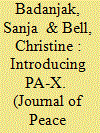

|
|
|
|
|
| Summary/Abstract |
This article introduces PA-X, a peace agreement database designed to improve understanding of negotiated pathways out of conflict. PA-X enables scholars, mediators, conflict parties and civil society actors to systematically compare how peace and transition processes formalize negotiated commitments in an attempt to move towards peace. PA-X provides an archive and comprehensive census of peace agreements using a broad definition to capture agreements at all phases of peace processes in both intrastate and interstate conflict, from 1990 to 2016. These comprise ceasefire, pre-negotiation, substantive (partial and comprehensive), and implementation agreements, disaggregated by country/entity, region, conflict type, agreement type and stage of agreement totalling over 1,500 agreements in more than 140 peace and transition processes. PA-X provides the full text of agreements, and qualitative and quantitative coding of 225 categories relating to politics, law, security, development and implementation. Data can be aggregated or merged with conflict datasets, effectively providing many datasets within one database. PA-X supports new comparative research on peace agreements, but also on peace processes – enabling tracing of how actors and issues change over time – to inform understandings of conflict termination. We illustrate PA-X applications by showing that an intricate peace process history correlates with reduced likelihood of conflict recurrence, and that cumulative provisions addressing elections see the quality of subsequent post-conflict elections improve.
|
|
|
|
|
|
|
|
|
|
|
|
|
|
|
|
| 15 |
ID:
164155
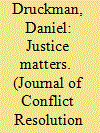

|
|
|
|
|
| Summary/Abstract |
Attaining durable peace (DP) after a civil war has proven to be a major challenge, as many negotiated agreements lapse into violence. How can negotiations to terminate civil wars be conducted and peace agreements formulated to contribute to lasting peace? This question is addressed in this study with a novel data set. Focusing on justice, we assess relationships between process (procedural justice [PJ]) and outcome (distributive justice [DJ]) justice on the one hand and stable agreements (SA) and DP on the other. Analyses of fifty peace agreements, which were reached from 1957 to 2008, showed a path from PJ to DJ to SA to DP: The justice variables were instrumental in enhancing both short- and long-term peace. These variables had a stronger impact on DP than a variety of contextual- and case-related factors. The empirical link between justice and peace has implications for the way that peace negotiations are structured.
|
|
|
|
|
|
|
|
|
|
|
|
|
|
|
|
| 16 |
ID:
159745
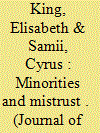

|
|
|
|
|
| Summary/Abstract |
An enduring debate in the conflict management literature concerns the wisdom of recognizing versus avoiding reference to ethnic identities in institutions to manage ethnic conflict. Understanding why ethnic recognition occurs is crucial for informing this debate. We develop a theory based on functional and political mobilization effects of recognizing ethnic groups. Contrary to reasoning that minority leaders would be most interested in recognition, the theory suggests that recognition consistently favors the interests of leaders from larger, plurality groups, whereas minority leaders face a ‘dilemma of recognition’ between functional gains and mobilization threats. We use mixed methods to test our theory. For our quantitative analysis, we draw on an original coding of recognition in constitutions and comprehensive political settlements from 1990 to 2012. We find that for cases with leaders from plurality groups, recognition is adopted 60% of the time. With leaders from minority groups, the rate is about 40 percentage points lower, even after accounting for many background factors. Additional quantitative tests and a qualitative analysis present more detailed evidence to show that the processes correspond to the logic of our theory. Answering these questions about when and why recognition is adopted is a crucial step in evaluating its effects on conflict.
|
|
|
|
|
|
|
|
|
|
|
|
|
|
|
|
| 17 |
ID:
183707


|
|
|
|
|
| Summary/Abstract |
A growing body of scholarship connects the participation of women and the inclusion of gender provisions to the sustainability of peace settlements. But how do women's groups navigate gender power structures and gendered forms of violence within complex and fragile political bargaining processes aimed at ending large-scale conflict? The 2016 Colombian peace agreement, internationally applauded for its inclusion of strong gender provisions and women's participation as negotiators and peace advocates, is a significant case for examining these questions. Drawing on original case material, including interviews of key actors on different sides of the conflict – this article analyses the political bargaining dynamics within and among women's movements, the Santos government and the Revolutionary Armed Forces of Colombia (Fuerzas Armadas Revolucionarias de Colombia, FARC). We argue that the inclusion of women was pivotal in transforming the elite bargaining process and power structures of Colombian society enabling a gender-based approach to the substantive peace agenda addressing transitional gender justice for sexual violence survivors and gender-equal redistribution through land and rural reform programmes. The study suggests that deeply situated political bargaining analysis is essential to navigating gender in elite bargains rather than a one-size-fits-all approach to inclusive peace.
|
|
|
|
|
|
|
|
|
|
|
|
|
|
|
|
| 18 |
ID:
144470


|
|
|
|
|
| Summary/Abstract |
This article examines the negotiation of security in landmark peace agreements brokered in Sudan (2002−2005) and Kenya (2008). It reviews the dominant literature on peace agreements, arguing that preoccupation with agreements' durability has led to the neglect of questions about whether and under what conditions agreements work to improve human security. The article calls for a different approach to analysis of peace agreements' quality that addresses how transformative they are of security conditions for ordinary people. Applying this lens to the Sudanese and Kenyan accords, it outlines the agreements' commitments to improved human security and the range of factors that shaped and undermined prospects for the realization of those commitments in practice, even prior to implementation. It concludes with lessons for international conflict resolution practitioners.
|
|
|
|
|
|
|
|
|
|
|
|
|
|
|
|
| 19 |
ID:
184179


|
|
|
|
|
| Summary/Abstract |
Based on conflict data, interviews and media monitoring, this study of Myanmar’s non-inclusive ceasefires develops a four-step argument about the effect of ceasefires in complex conflict systems. First, non-state armed groups rarely co-ordinate their actions strategically. This makes it easy for governments to obtain ceasefires with some groups while fighting others. Second, when ceasefires ensure armed groups’ survival, they mostly hold. Third, non-inclusive ceasefires do not reduce a country’s overall level of violence, since fighting tends to escalate with excluded groups. On this basis we conclude that non-inclusive ceasefires do not present a viable alternative to an inclusive peace process.
|
|
|
|
|
|
|
|
|
|
|
|
|
|
|
|
| 20 |
ID:
167284
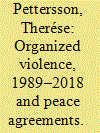

|
|
|
|
|
| Summary/Abstract |
This article reports on trends in organized violence and peace agreements collected by the Uppsala Conflict Data Program (UCDP). The number of fatalities in organized violence decreased for the fourth consecutive year, to reach the lowest level since 2012. In 2018, UCDP recorded almost 76,000 deaths: a decrease of 20% compared to 2017, and 43% compared to the latest peak in 2014. State-based armed conflict drives this downward trend in organized violence, with Syria accounting for much of the change. The number of civilians killed in one-sided violence also dropped in 2018, reaching its lowest level since 2012. In contrast, non-state conflict remained on a high level. The general decline in fatalities from organized violence does not correspond with the trend in the number of active conflicts. In fact, the world has seen a new peak in the number of conflicts after 2014, matched only by the number of conflicts in the early 1990s. In 1991, the peak in the number of armed conflicts corresponded with a similar peak in the number of signed peace agreements. This was followed by a decrease in the number of conflicts in the late 1990s and early 2000s. However, the most recent rise in armed conflicts has not been matched by a similar rise in the number of peace agreements. Two circumstances that characterize the recent rise in conflicts have also been found to make conflicts harder to solve: explicit religious claims and high levels of internationalization.
|
|
|
|
|
|
|
|
|
|
|
|
|
|
|
|
|
|
|
|
|